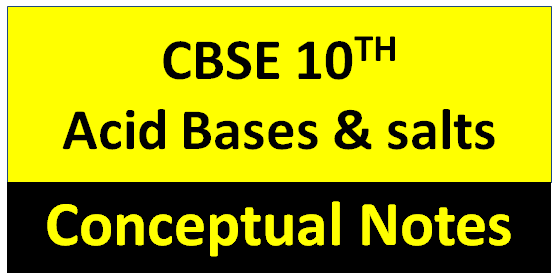
Acid Bases and Salts
Acid
- Chemical Substance which turn blue litmus red & when dissolved in water , dissociate to give H+ ions
- Acids are sour in Taste
- Corrosive in nature
Base
- Chemical substance which turn red litmus blue & when dissolved in water , dissociate to give OH¯ ions .
- Bitter in Taste
- Feel soapy , soft to touch
- All bases are not soluble in water
- Bases which are soluble in water→Alkali
Salt
- Formed when an acid reacts with a base
- CaCl2 ,KCl, Na2SO4 NaNO3 etc
Indicators
Substance that are used to test whether a substance is acidic or basic or neutral in nature
Types of Indicators
- Natural
- Synthetic
- Olfactory
| Natural | Synthetic | Olfactory |
| Litmus paper | Phenolphthalein | Onion |
| Turmeric | Methyl Orange | Vanilla |
| Red Cabbage | Methyl Orange | Clove |
Chemical Properties
Reaction of an acid with metals :-
Acid + Metal → salt + Hydrogen gas
- Mg+2HCl →MgCl2 +H2 (g)
-
Zn + H2SO4 → ZnSO4 (aq) + H2 (g)
- Cu(s) + HCl → No reaction
Reaction of a base with metals
- 2NaOH + Zn → Na2ZnO2 + H2
Reaction of an metal carbonates /Hydrogen carbonates with Acid
Metal Carbonates/Hydrogen carbonates + Acid → Salt +Co2 + H2O
- Na2Co3 (s)+ 2HCl (aq)→ 2NaCl (aq) + H2O (l)+ CO2 (g)
-
NaHCO3 (s) + HCl (aq)→ NaCl (aq)+ H2O (l)+ CO2 (g)
On passing the CO2 gas evolved through lime water
-
Ca(OH)2 (aq) + CO2 (g) → CaCO3 ( s) + H2O(l)
-
CaCO3 (s) + H2O (l) + CO2(g) → Ca(HCO3)2 (aq) Soluble in water
Reactions of acids & bases / Neutralisation reaction
Base + Acid → Salt + water
NaOH (aq) + HCl(aq) → NaCl(aq) + H2O(l)
Reaction of Metallic oxides with Acids
Metal Oxide + Acid → Salt + Water
CaO(aq) + 2HCl(aq) → CaCl2(aq) + H2O (l)
Reaction of Non metallic oxide with Base
Non-Metal oxide + Base → Salt + water
CO2 (aq) + 2NaOH (aq) → Na2CO3(aq) + H2O (l)
Why do all acids and all bases have in common ?
- Acids or base solutions in water conducts electricity
- Acids or base dissociate into ions when added in water
- Separation of ions from the compound is not possible in the absence of water
-
C2H5OH C6H12O6
- HCl + H2O → H3O + Cl–
-
NaOH + H2O → Na+ + OH–
Can we add water directly into an acid ?
- The process of dissolving an acid or a base in water is a highly exothermic one
- The acid must always be added slowly to water with constant stirring
- if water is added to a concentrated acid the heat generated may cause the mixture to splash out and cause burns
Dilution
- Mixing an acid or base with water results in decrease in the concentration of ions (H3O+/OH-)
- such a process is called dilution and the acid or the base is said to be diluted
Strength of an acid
- The more will be the H+ion dissociated the strength will be an acid
- Dissociation of H+ion in water depends on the strength of the bond between hydrogen and other component
- stronger will be the bond the lesser will be the dissociation and vice versa
- therefore HCl is more acidic than H2SO4
Strength of a base
- we already know that bases are the chemicals which dissociates OH– into ion when dissolved in water
- Similarly the more will be the OH– ion dissociates the stronger will be the base
- The universal indicator shows different colours at different concentrations of hydrogen ions in a solution
Importance of pH in everyday life :-
Our body works within the pH range of 7.0 to 7.8
pH of the soil in our backyard
plants require a specific pH range for their healthy growth
- slightly basic →CaO/CaCO3
- Slightly acidic → decayed organic matter
pH in Our digestive system
our stomach produces hydrochloric acid which helps in the digestion of food without harming the stomach
- Antacid-Milk of Magnesia
- Baking Soda
pH change as the cause of tooth decay
Tooth decay starts when the pH of the mouth is lower than 5.5
Self defence by animals & plants through chemical welfare
Bee-Sting leaves an acid which causes pain & irritation. use of a mild base like baking soda on the stung area gives relief
pH of salts
- Salts of a strong acid & a strong base are neutral with pH value of 7. e.g-Nacl
- Salts of a strong acid & a weak base are acidic with pH value less than 7. e.g-CuCl2
- salts of a strong base & weak acid are basic in nature with pH value more than 7. e,g- Na2CO3
Sodium Hydroxide
Method of Preparation- Chlor Alakli process
2NaCl + 2H2O → 2NaOH + Cl2 + H2
Uses
- For making soaps, detergents
- for making papers , plasticides PVC , disinfectants
Bleaching water
- Produced by the action of chlorine or dry slaked lime ⌈Ca(OH)2⌉
- represented as CaOCl2
-
Ca(OH)2 + Cl2 → CaOCl2 + H2O
Uses
- for bleaching cotton & linen in the textile industries
- used as an oxidising agent in many chemical industries
- for disinfecting drinking water to make it free of germs
Baking Soda
- Chemical Name-sodium hydrogen carbonate ⌈NaHCO3⌉
- Manufacture of baking soda -solvable process
- produced by using sodium chloride as one of the raw materials
-
NaCl + H2O + CO2 + NH3 → NH4Cl + NaHCO3
Uses
- making of baking powder which is used in making cakes , fire extinguishes
washing Soda
- Re crystallisation of sodium carbonate gives washing soda . it is basic salt
- Na2CO3 + 10H2O → Na2CO3.H2O
Uses
- in paper industries , in soap industries as a cleaning agent for domestic purposes for removing permanent hardness of water
water of Crystallisation
- it means having a fixed number of modules present in one formula of a unit of salt
- caused by forming purified crystals from an aqueous solution
- e.g-hydrated copper sulphate CuSO4 .5H2O
Gypsum
- Chemical formula -CaSO4.2H2O
- it has two water molecules as water of crystallisation
Plaster of Paris
- Chemical formula -CaSO4 1/2H2O
- On heating gypsum at 373K it loses water molecules & becomes calcium sulphate hemihydrate
Heating of POP
- CaSO4.2H2O → CaSO4.1/2H2O + 3/2H2O
Uses
- It is used as plaster for supporting fractured bones in the right position , to make sculptures & used as decorative in buildings a coating on wood and metal structures to avoid any fire accidents






